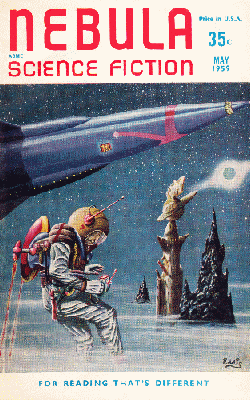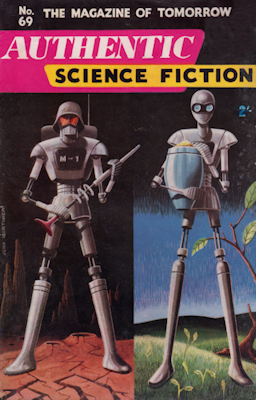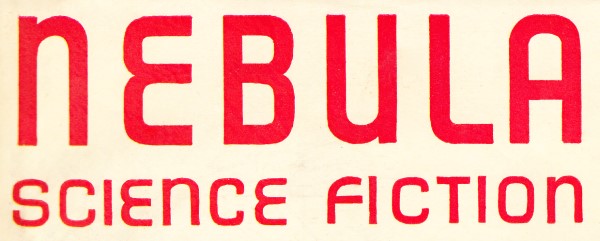Links to Bibliographies
The Big Three
--- Isaac Asimov
--- Arthur C. Clarke
--- Robert A. Heinlein
Science Fiction Magazines
--- Introduction
--- Authentic Science Fiction
--- Nebula Science Fiction
--- Vision of Tomorrow
Science Fiction and Fantasy Series
SF Universes and Fantasy Worlds
|
|
|
 Sometimes the collector in me will out, come what may.
Sometimes the collector in me will out, come what may.
Nebula Science Fiction magazine is a case in point. I started tracking down a dozen copies as part of my Philip E. High collection. There I also found stories by familiar author's such as Robert Silverberg, Brian Aldiss, Bob Shaw and John Brunner along with more from new (to me) authors like E.C. Tubb, Kenneth Bulmer and Eric Frank Russell.
The cover artwork was especially distinctive to this child of the seventies and eighties and harks back to a time and style unfamiliar to one who learned what a spaceship looked like from Star Wars and Battlestar Galactica. A familiar name cropped up here too: Eddie Jones - known to me for his Venture Science Fiction covers - contributed cover illustrations to three issues of Nebula. His style had changed in the intervening thirty years, but his passion for science fiction shines through.
Later, even though I had located copies of all of Philip E. High's stories for Nebula, the fact that I had a good selection of issues, but not a complete set, got my collecting juices flowing and the hunt was on. There was no hurry, so I didn't pay more than a few pounds per issue. Eventually, I managed to complete the set and here they are in all their 1950s glory.
Nebula Science Fiction was the brainchild of Peter Hamilton Jr. His parents ran a printing company in Glasgow and were persuaded by their son that they should print and publish science fiction novels to utilize spare capacity on their machines. A local wholesaler advised that a regularly published magazine would be more likely to achieve better sales, so Peter was installed as editor and Issue 1 was published in Autumn 1952.
For much of its life, publication of Nebula was somewhat irregular, even when Hamilton himself became publisher and printing was farmed out to other print houses. A total of 41 issues were published before the magazine folded in mid-1959 due to several factors, including the publisher's ill-health, changing reading habits and new restrictions and costs limiting overseas markets.
 My interest in Authentic Science Fiction began in the same way, with eight issues in the Philip E. High collection. Unsurprisingly, many of the same authors stories appeared there. What was different with Authentic was the approach. Where Nebula was the epitome of consistency, Authentic was anything but. Cover artwork and design, content type and mix, even the title, all were in a continual state of evolution over the course of its seven-year life span.
My interest in Authentic Science Fiction began in the same way, with eight issues in the Philip E. High collection. Unsurprisingly, many of the same authors stories appeared there. What was different with Authentic was the approach. Where Nebula was the epitome of consistency, Authentic was anything but. Cover artwork and design, content type and mix, even the title, all were in a continual state of evolution over the course of its seven-year life span.
Originally intended as a science fiction book series with volumes being published twice per month beginning in January 1951, Authentic was gradually reinvented as a magazine, although its content was centred around a complete novel until issue 26, when it also included a serial for the first time. Short stories and scientific articles also began to appear in the following issues, and complete novels were dropped to allow a greater mix of content. The end came after 85 issues, when Authentic's publisher Hamilton & Co. wound up the magazine in October 1957 to focus its efforts on paperback novels.
Two spin-offs from Authentic Science Fiction were also published. The first, the Authentic Science Fiction Hand-Book, was an encyclopaedic guide to science and science fiction terminology, that expanded on a series compiled by editor H.J. Campbell for Authentic magazine. The second, the Authentic Book of Space, was an anthology of short fiction and science articles, mostly by regular contributors to Authentic, that also included a graphic story and a board game.
This section of SFandFantasy.co.uk will be growing over the coming months and years to include other British science fiction and fantasy magazines such as Interzone, New Worlds Science Fiction, Science Fantasy, SF Impulse and Venture Science Fiction.
The illustrated bibliographies compiled so far are:
References
- Eight Miles Higher - 'Authentic SF' - But Sometimes InAuthentic Too…! - an article by Andrew Darlington - retrieved 15 July 2017
- Galactic Central - Authentic Science Fiction - retrieved 15 July 2017
- Galactic Central - Nebula Science Fiction - retrieved 14 December 2013
- Jim Linwood - Nebula Science Fiction 1952-1959 - a detailed resource for Nebula SF - retrieved 25 February 2023
- Rob Hanson - Coroncon 1953 - an account of the convention including photos of Peter Hamilton - retrieved 02 August 2014
- The Encyclopedia of Science Fiction - Authentic Science Fiction - retrieved 15 July 2017
- The Encyclopedia of Science Fiction - Nebula Science Fiction - retrieved 14 December 2013
- The Internet Speculative Fiction Database - Authentic Science Fiction - retrieved 15 July 2017
- The Internet Speculative Fiction Database - Nebula Science Fiction - retrieved 14 December 2013
- Wikipedia - Authentic Science Fiction - retrieved 15 July 2017
- Wikipedia - Nebula Science Fiction - retrieved 14 December 2013
|
|
|




